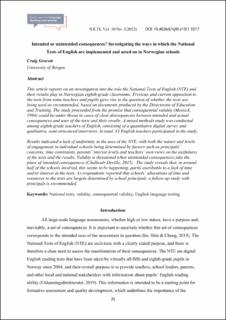| dc.contributor.author | Grocott, Craig | |
| dc.date.accessioned | 2023-03-01T14:23:01Z | |
| dc.date.available | 2023-03-01T14:23:01Z | |
| dc.date.created | 2022-11-02T16:08:40Z | |
| dc.date.issued | 2022 | |
| dc.identifier.issn | 2703-8629 | |
| dc.identifier.uri | https://hdl.handle.net/11250/3055072 | |
| dc.description.abstract | This article reports on an investigation into the role the National Tests of English (NTE) and their results play in Norwegian eighth-grade classrooms. Previous and current opposition to the tests from some teachers and pupils gave rise to the question of whether the tests are being used as recommended, based on documents produced by the Directorate of Education and Training. The study proceeded from the premise that consequential validity (Messick, 1994) could be under threat in cases of clear discrepancies between intended and actual consequences and uses of the tests and their results. A mixed methods study was conducted among eighth-grade teachers of English, consisting of a quantitative digital survey and qualitative, semi-structured interviews. In total, 43 English teachers participated in the study.
Results indicated a lack of uniformity in the uses of the NTE, with both the nature and levels of engagement in individual schools being determined by factors such as principals’ concerns, time constraints, parents’ interest levels and teachers’ own views on the usefulness of the tests and the results. Validity is threatened when unintended consequences take the place of intended consequences (Chalhoub-Deville, 2015). The study reveals that, in around half of the schools involved, this seems to be happening, partly ascribable to a lack of time and/or interest in the tests. As respondents reported that schools’ allocations of time and resources to the tests are largely determined by school principals, a follow-up study with principals is recommended. | en_US |
| dc.language.iso | eng | en_US |
| dc.relation.uri | https://journal.uia.no/index.php/NJLTL/article/view/1017 | |
| dc.rights | Navngivelse-Ikkekommersiell 4.0 Internasjonal | * |
| dc.rights.uri | http://creativecommons.org/licenses/by-nc/4.0/deed.no | * |
| dc.title | Intended or unintended consequences? Assessing the ways in which the National Tests of English are implemented and acted on in Norwegian schools | en_US |
| dc.type | Journal article | en_US |
| dc.type | Peer reviewed | en_US |
| dc.description.version | publishedVersion | en_US |
| dc.rights.holder | Copyright 2022 The Author(s) | en_US |
| cristin.ispublished | true | |
| cristin.fulltext | original | |
| cristin.qualitycode | 1 | |
| dc.identifier.doi | 10.46364/njltl.v10i1.1017 | |
| dc.identifier.cristin | 2068234 | |
| dc.source.journal | Nordic Journal of Language Teaching and Learning (NJLTL) | en_US |
| dc.source.pagenumber | 25-51 | en_US |
| dc.identifier.citation | Nordic Journal of Language Teaching and Learning (NJLTL). 2022, 10 (1), 25-51 | en_US |
| dc.source.volume | 10 | en_US |
| dc.source.issue | 1 | en_US |

